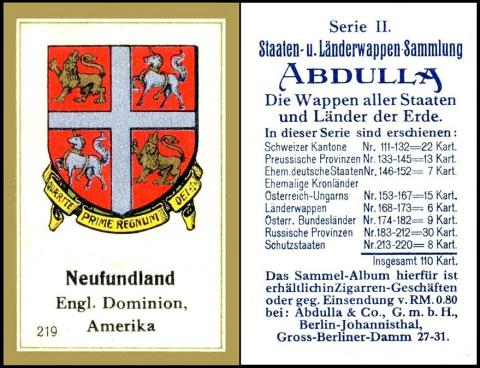
This card is here because it celebrates the Newfoundland dog, which originated in what we now know as Canada. Originally this was a working dog, most probably because its large stature lends itself to pulling carts - they can grow to weigh 150 pounds. Now we know them as black, but there were once other colours, grey, brown, and a mixture of black and white.
However Britain`s most popular dog at the moment, the Labrador Retriever, also comes from those shores, where it is known as a St. John`s Water Dog. Some of these dogs were imported to the United Kingdom, many years ago, and they were bred to form today`s Labrador, named after that region of Canada.
So here we have the coat of arms of Newfoundland. Like the flag, this has undergone changes - and for the same reason, for when our British fishermen started to visit there from the last sixteenth century onwards we tried to claim it as our own, going as far as to appoint a naval governor in the mid eighteenth century. By 1840 there was a local flag, nothing to do with the original native inhabitants, of course, it had the curious colourway of being green, white and pink stripes. And Newfoundland kept these links with Great Britain, even changing the flag to the Union Jack in the 1930s. It even resisted becoming part of Canada until 1949.
The coat of arms was originally granted in 1638, by King Charles I. It was described as red, gold, and silver, with four quarters, two of them a walking lion, wearing a gold crown, and looking at the viewer, and two of them a crowned unicorn with a chain between his legs and over his back. And on the top an elk, walking, despite the fact that there are no elk in Newfoundland. Beside these, supporting the shield, were two people (described as "savages") ready to go to war. Beneath this the banner proclaims, in Latin, "Seek ye first the kingdom of God.", which is a biblical quote. Now it says that within a few years it fell into disuse, but there is a hidden story because the governor for whom it was made was arrested, whilst fighting in the English Civil War, sent to prison, and died.
When the War Graves Commission asked for a coat of arms to be used on the graves of Newfoundland men, nobody knew. Much searching and legal documentation followed, and this early one was re-discovered. In 1928 the government officially adopted it, which is not so many years before our card made its appearance. It looks like perhaps at that time they were only using the shield and not the supporters. Or maybe such would not have fitted between the boundaries of this card.
I thought this set would be in our Cartophilic reference book No.5, issued in 1943, which covers the issues of Abdulla, along with Adkin and Anstie. However it is not, because it turns out that this booklet only covers the English language issues. That means this set`s first appearance comes in our original World Tobacco Issues Index, with the other German Language Issues as section one of the Abdulla listings. And the entry there reads :
LANDERWAPPEN-SAMMLUNG (Coat of Arms Series). Sm. 65 x 45. Nd. ... A5-3
1. "Die Wappen der Fuhrenden Staaten der Erde" (Arms of the Leading Countries of the World). Nd. 1/110.
2. "Serie II. Staaten u. Landerwappen Sammlung" (Arms of Provinces and Countries) Nd. 111-220 (110)
3. "Serie III. Wappen-Sammlung auslandischer Haupstadte" (Arms of Foreign Towns etc). Nd 1/150
This text is identical in our updated version, except for the code.
